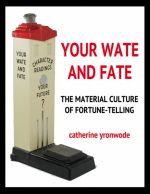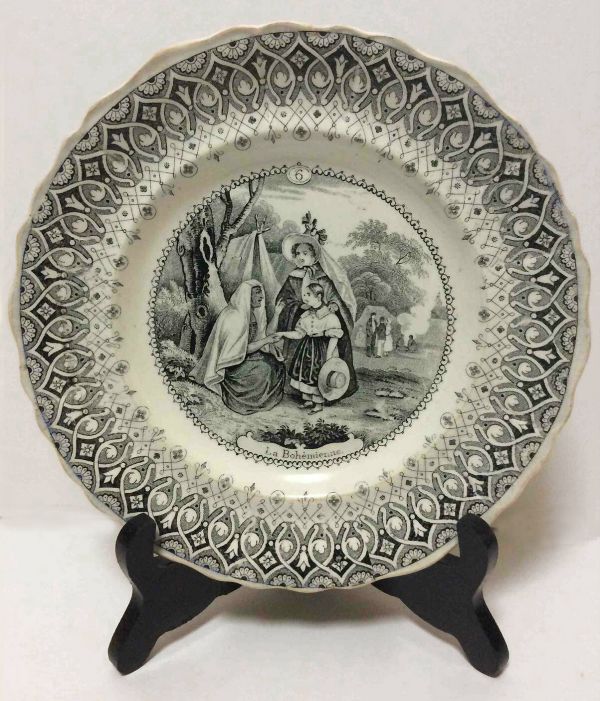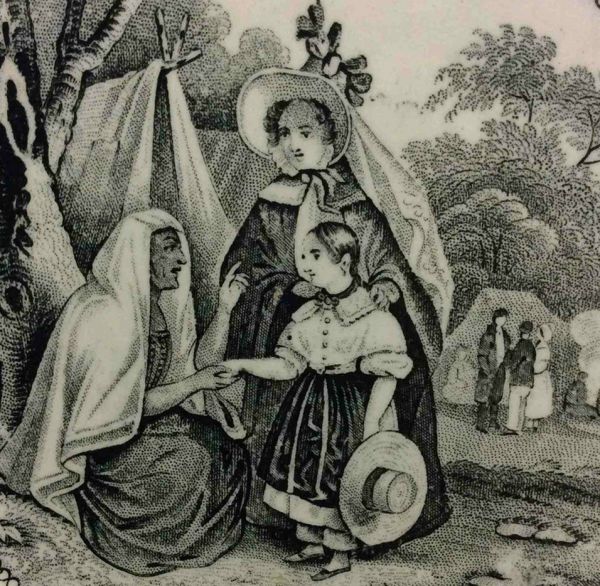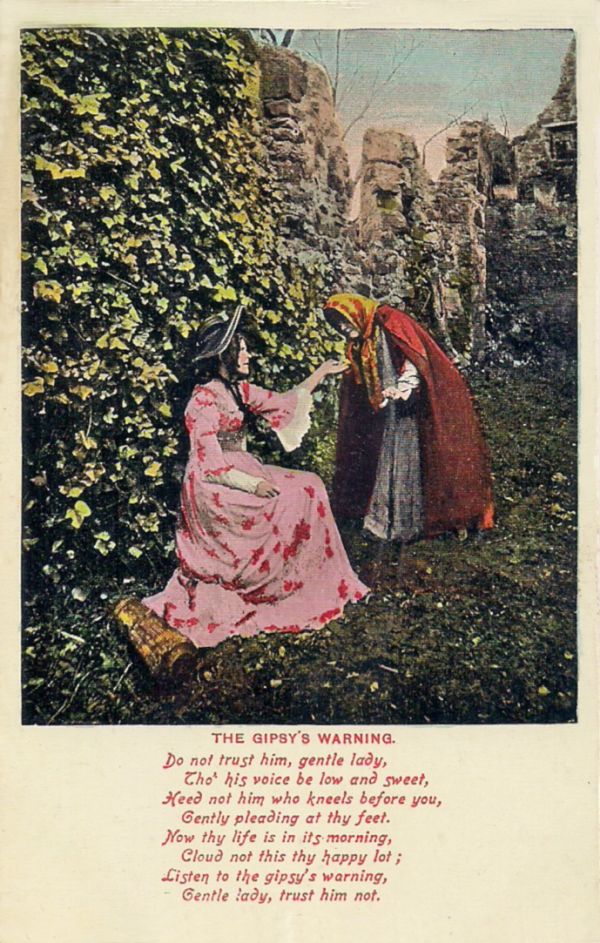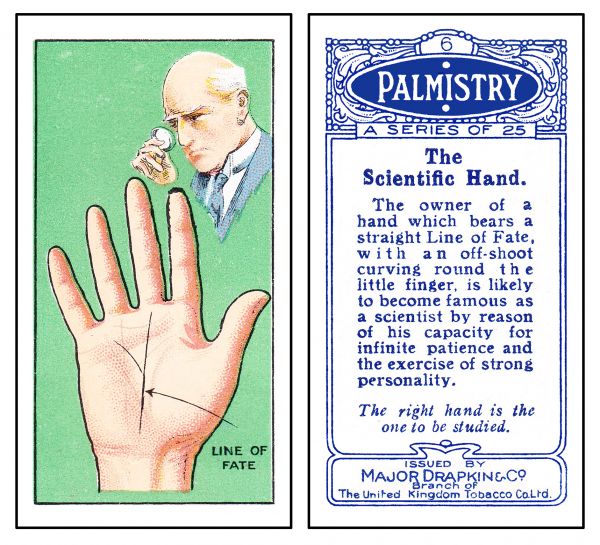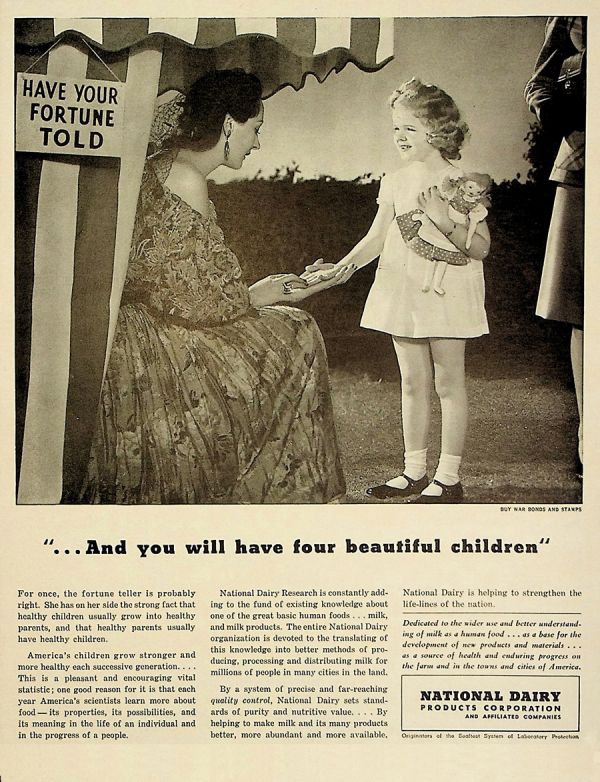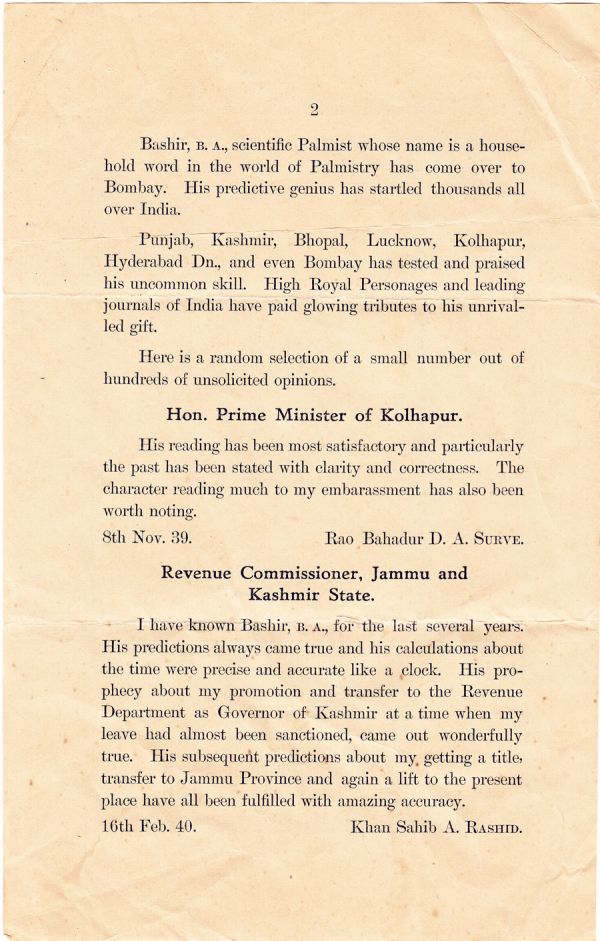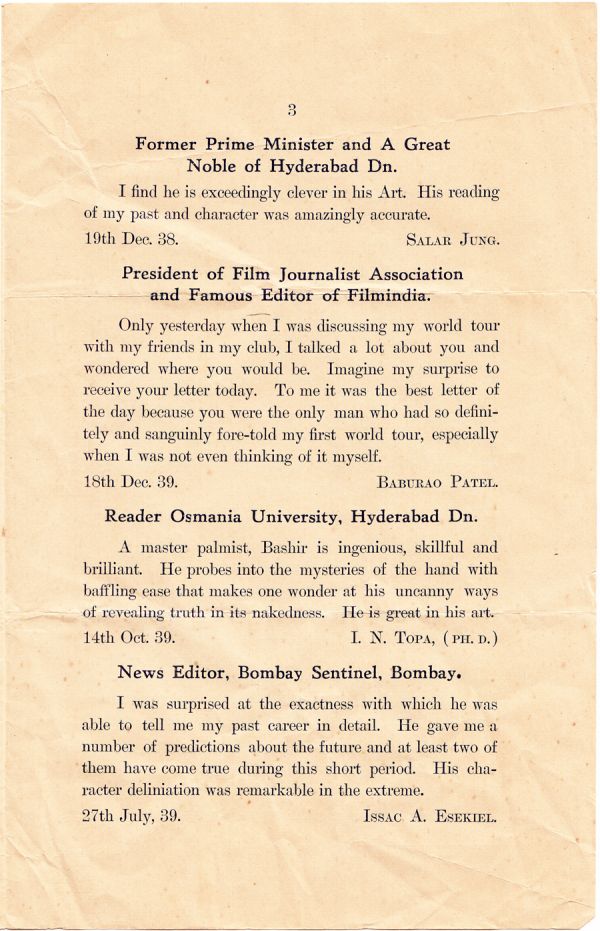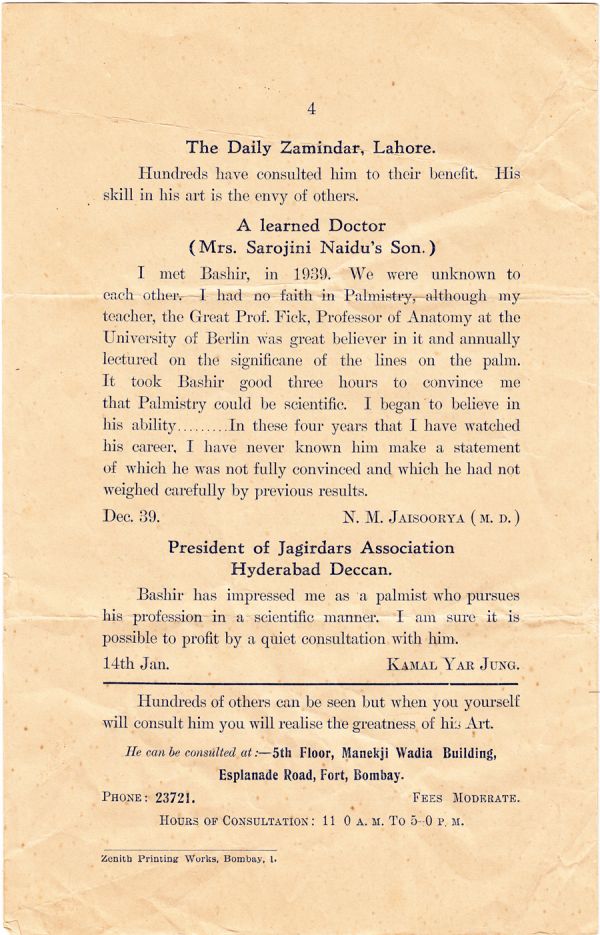Palmistry and Palm Readers: Difference between revisions
(typo patrol) |
(edit and save) |
||
| Line 55: | Line 55: | ||
This four-page flyer, printed in Bombay (now Mumbai), India, in 1940, shows how respectable and normal palm reading was in India, at a time when American palm readers often were treated as outsiders and frauds. | This four-page flyer, printed in Bombay (now Mumbai), India, in 1940, shows how respectable and normal palm reading was in India, at a time when American palm readers often were treated as outsiders and frauds. | ||
[[File:bashir-ba-palmistry-flyer-page-1-smaller.jpg|center|600px|thumb|Page 1 of the 1940 advertising flyer for Bashir, B.A., a scientific Indian palmist located in Bombay (now Mumbai), India.]] | [[File:bashir-ba-palmistry-flyer-page-1-smaller.jpg|center|600px|thumb|Page 1 of the 1940 advertising flyer for Bashir, B.A., a scientific Indian palmist located in Bombay (now Mumbai), India. The terms "Zamindar" and "Jagirdar" on this page refer to an autocratic land-owning class established in the 13th century under Muslim rule, similar to European feudal lords. The Jagirdar system continued under British colonial rule, but in 1951, after Indian independence and the partition of Pakistan and Bangladesh, it was abolished.]] | ||
[[File:bashir-ba-palmistry-flyer-page-2-smaller.jpg|center|600px|thumb|Page 2 of the 1940 advertising flyer Bashir, B.A., showcasing testimonials from a politician and a well-placed bureaucrat.]] | [[File:bashir-ba-palmistry-flyer-page-2-smaller.jpg|center|600px|thumb|Page 2 of the 1940 advertising flyer Bashir, B.A., showcasing testimonials from a politician and a well-placed bureaucrat.]] | ||
Revision as of 17:15, 16 September 2021
In this installment of "Your Wate and Fate," we take a sneak-peek look at an upcoming page that will eventually be on display to the public. As a Patreon supporter, you have access to the page one full year before the public does.
- Patreon Release Date: September 15th, 2021
- Public Release Date: September 15th, 2022.
Please tell your friends that they can subscribe to my Patreon stream for $2.00 per week:
To discuss this and other Your Wate and Fate pages with me, join my private Patreon Forum here:
As a form of divination, palmistry combines character analysis with fortune telling. Most readers consider it to be one of the more scientific forms of prediction, because a great many of the features of the hand are determined by genetics, including the presence of congenital diseases and the likelihood of the sitter following a career that an ancestor also pursued.
As far as i can tell, the scientific study of palm reading began or became widely popular in India, centuries ago. It travelled to Europe with the Romani people, who date their movement Westward to the time of Alexander the Great, and still maintain many Indian customs and beliefs.
Hand reading was soon associated with Romani practitioners in Eastern Europe. As these people, wrongly called "Gypsies" by Europeans who thought that they had come from Egypt, moved Westward into Europe and Great Britain, they actually brought two popular forms of fortune telling with them — palm reading and fortune telling with birds. Both of these were practiced in public, by women, the Romani men being mostly horse trainers, dealers, and brokers, a hereditary trade in their culture, and a vital part of their nomadic lifestyle. That nomadic life, which led to their unaccountability to local authorities, also led to discrimination against the Romani, and an othering of their way of life. Words like mysterious, exotic, strange, and weird were attached to them.
Eventually, because so many settled in the region then known as Bohemia (now the Czech Republic), they came to be known as Bohemians, a word that, in turn, came to mean anyone, from any culture or region, who chooses to live outside of society's conventional norms. The Bohemian lifestyle was one of freedom, eccentricity, and reduced accountability to the capitalist state. These days the derivative fashion term Boho refers to garments that are free flowing, with long skirts and full sleeves, resembling the clothes of the 19th century Romani in Bohemia.
Some of the first experiences Americans and Europeans had with palmistry as a form of character analysis or fortune telling was with Romani women who read their hands. In the 19th century, the Romani were forbidden to set up shops or permanent dwellings, and lived in camps outside of towns, coming in to trade at towns during feast days, market days, and fairs. The bolder seekers after fortunes would ride or walk out to the "Gypsy camp" to have their futures told.
The image of the uncanny, frightening :"Gypsy woman" who reads the hand and makes dire predictions reached a height in Britain and America during the late Victorian era and continued well on into the 20th century. A common topic for postcards, the image was usually that of a young Anglo woman having her hand read by an old Romani woman, out of doors, either amidst ruins or near a campsite.
In time, the elderly Romani woman began to fuse with the English and American stereotype of "the witch," a hook-nosed woman who wore clothes similar to Welsh villagers and who was thought to have evil intentions toward more culturally normative women. The "gypsy witch" competed with the "Bohemian gypsy" as a stereotype for decades.
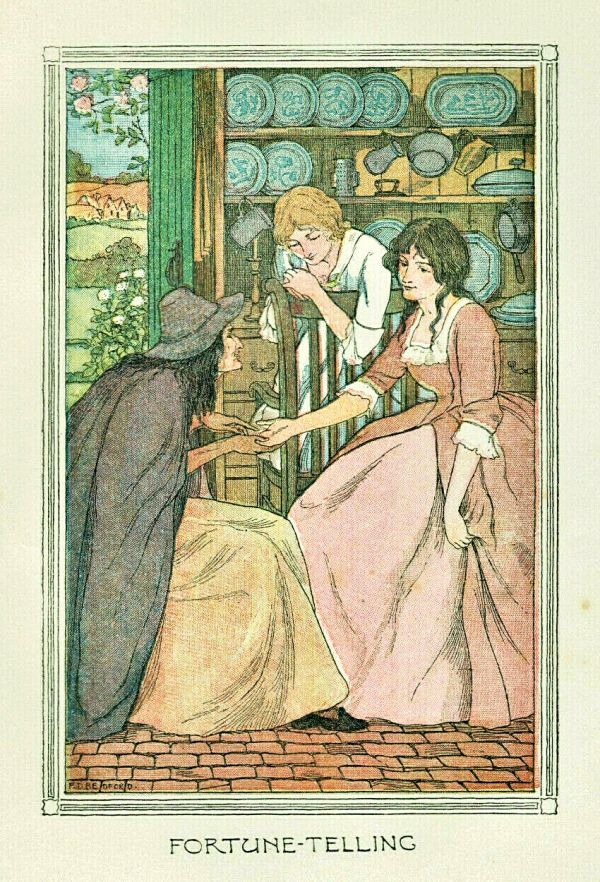
Despite the stereotypes surrounding palmistry as the inherently fraudulent but weirdly accurate mutterings of old Romani women, palmistry itself, as a form of reading, gained much popularity in America and England around the beginning of the 20th century. The artist Harry Roseland, who documented the life of a professional African-American fortune teller in New York City from the 1890s through the 1920s, painted her as a cartomancer, tea leaf reader, crystal scryer, and palmist. In keeping with the theme of the reader as outside mainstream culture, her client was a sweet young Anglo-Saxon woman, but because Roseland sought to uplift the kindliness and normality of the black reader, the scene is homey and domestic, and the title of the picture is "Good Luck, Honey."
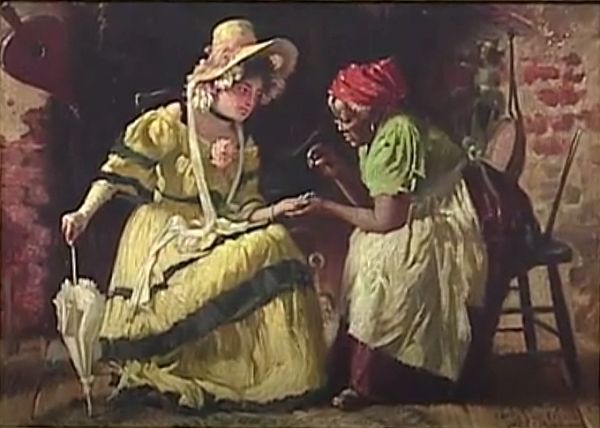
Around this time terms like "scientific palmistry" and "medical palmistry" began to be applied to palm reading, in keeping with its obvious connections to physical traits. The "scientific palmistry" systems derived from Indian teachers, not from the wandering Bohemian Romani. Scientific palm readers were known for their accuracy, and because of them palmistry became extremely popular in Europe and North America. Common people of all walks of life, both male and female, sought to learn how to read the hand. Instruction books and flash cards were easy to find.
By the 1940s, palmistry was well accepted in America. It was so much a part of American life that it was even used as a theme in institutional magazine advertisements. For instance, this ad for the National Dairy Products Corporation links the Romani reader — now a kindly young woman of maternal mien -- with the word "scientific," as the mother has her little girl's hand read, and only good things are foretold. The tattered, rural campsite of La Bohemiénne is now a striped carnival tent at a county fair, and although the reader still shows a bit of exoticism by letting her blouse fall off her shoulder, the mother, mostly cropped out of the photo, wears a smart woolen suit and probably approves of the divination.
Meanwhile, in India, the land where palmistry originated, with no negative or exotic stereotypes to confront and overcome, palmistry persisted as a well-known and culturally approved form of character analysis and prognostication.
This four-page flyer, printed in Bombay (now Mumbai), India, in 1940, shows how respectable and normal palm reading was in India, at a time when American palm readers often were treated as outsiders and frauds.
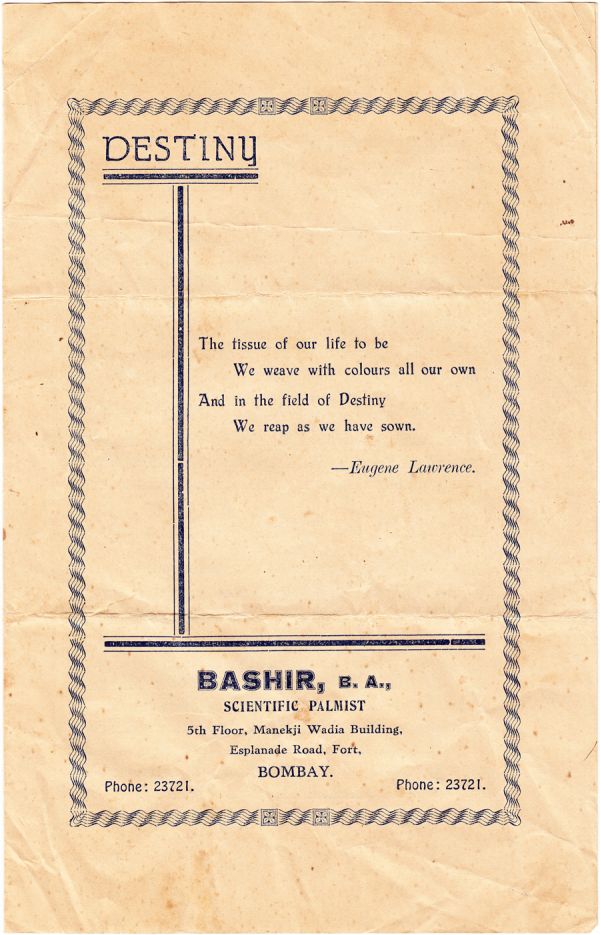
By the time that genetics entered the palmistry picture in the late 20th century, the concept of "scientific palmistry" and "medical palmistry" was finally accepted, and the idea that palm reading, a much-maligned form of fortune telling had held and preserved so many interesting genetic markers served to remove some of the stigma from its traditional practice in Europe and America.
